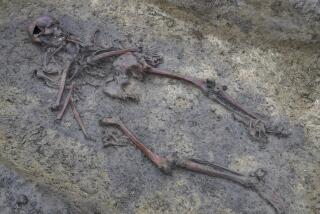Finland Sinks to New Level in Shipwreck Exhibits: Undersea
- Share via
HELSINKI, Finland — In the brackish waters of the archipelago that stretches 300 miles along Finland’s southern coast, more than 600 sunken ships dating back to the Viking era make up a little-visited underwater museum recounting the Baltic region’s seafaring tragedies.
The rock- and island-strewn channel that narrows to less than 50 miles in places was a major trading route from Western Europe to St. Petersburg in the northern Russian city’s imperial heyday, and as such, it is littered with lost treasures that went down with ill-fated ships.
But in Finland’s wreck-rich territorial waters, salvaging valuables is not a matter of finders keepers. All “submerged heritage” belongs to the National Board of Antiquities on behalf of the general population, and the archeological wardens often have neither the means nor the inclination to bring the water-bound artifacts to the surface.
Instead, the board and the Maritime Museum of Finland have just created a diving park around the 1788 wreck of the Swedish warship Kronprins Gustav Adolf, just south of here, where visitors follow a fixed rope to the 163-foot gunship and read its history from explanatory signs, as in any other museum.
For those more comfortable viewing shipwreck history from land, the museum also has a special summer exhibit at the Cable Factory cultural center in Helsinki, the capital, called “Ships Lost at Sea,” recounting the fate of 11 famous sinkings.
The latest wreck to be located and included in the exhibit, the double-masted Vrouw Maria that sank south of Turku in 1771, was explored for the first time this month and found remarkably intact.
Film made by volunteer divers suggests that the Vrouw Maria, sitting upright on its keel in 130 feet of water, may still entomb the priceless Dutch master paintings it was carrying for Catherine the Great when it sank en route from Amsterdam to St. Petersburg.
“The waters in the Baltic Sea are unique in this area. There is almost nothing in the water that will corrode wood, so the wrecks survive in very good condition even after more than 200 years,” said Ismo Malinen, the curator who has assembled the exhibit.
The displays, which will move in September to the Maritime Museum in Hylkysaari, an island off Helsinki, are set in an eerie atmosphere simulating a ship in distress. Recorded creaks and groans and crashing waves bombard the visitor in darkened corridors lighted only by the flickering flames of a purported fire below deck.
The Vrouw Maria was located a little more than a year ago by members of an underwater archeology club, Pro Vrouw Maria, using side-scan sonar and archives in which the ship’s captain and nine crewmen, all of whom survived, described the location of the sinking, said Matias Laitinen, the antiquities official researching the latest undersea find.
Researchers can easily find their way back to the site with global positioning technology, but they have marked a one-mile no-entry radius around the surface to warn off would-be poachers or sailors who might accidentally damage the wreckage.
“We need to document the archeological details first. That’s what’s most important,” Laitinen said, explaining that there are no immediate plans to salvage the cargo.
But the Vrouw Maria’s discovery has added a fresh chapter to the underwater history of the Baltic and lured hundreds daily to the exhibits.
Among the displays in the Cable Factory here is the priceless salvage of Meissen porcelain and gold snuffboxes lifted out of the wreckage of the St. Michael, a sister ship of the Vrouw Maria that sank in 1747. Amateur divers spotted the St. Michael off Turku nearly 50 years ago, but its cargo was raised only in 1995, Laitinen said.
The antiquities board deals only with shipwrecks from 100 or more years ago, but the exhibit pays somber tribute to the worst modern sea disaster in the Baltic: the 1994 sinking of the ferry Estonia in which 852 passengers and crew members died. The display consists solely of an empty 25-person life raft suspended over a mock sea amid searchlights and wind-whipped waves.
*
Williams was recently on assignment in Finland.
More to Read
Sign up for Essential California
The most important California stories and recommendations in your inbox every morning.
You may occasionally receive promotional content from the Los Angeles Times.














